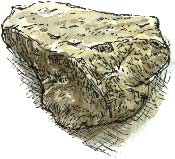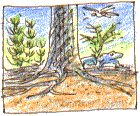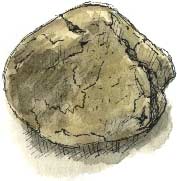 THIS
SANDSTONE fragment and pebble, which I picked up from a flower bed at
Barbara's mum's, are the bedrock of the small town of Horbury,
in fact this particular bed of sandstone is known as the Horbury Rock and
is made up of fine grains of sand from a delta which stretched from here
north to the M1/M62 junction near Lofthouse, east
beyond Castleford and to the south-east as far as Upton; an area of at least
10 x 25 kilometres (6 x 15 miles).
THIS
SANDSTONE fragment and pebble, which I picked up from a flower bed at
Barbara's mum's, are the bedrock of the small town of Horbury,
in fact this particular bed of sandstone is known as the Horbury Rock and
is made up of fine grains of sand from a delta which stretched from here
north to the M1/M62 junction near Lofthouse, east
beyond Castleford and to the south-east as far as Upton; an area of at least
10 x 25 kilometres (6 x 15 miles).
Lost World
 Not
that there were towns and motorways at the time; you'd have needed a canoe
to explore the tropical lagoons and backwaters of the river. Dragonflies
the size of sea-gulls whirred about, huge cockroaches and centipedes trundled
through the undergrowth and giant newt-like amphibians the size of crocodiles
hauled themselves out into the lush forests of giant club-mosses and
horse-tails.
Not
that there were towns and motorways at the time; you'd have needed a canoe
to explore the tropical lagoons and backwaters of the river. Dragonflies
the size of sea-gulls whirred about, huge cockroaches and centipedes trundled
through the undergrowth and giant newt-like amphibians the size of crocodiles
hauled themselves out into the lush forests of giant club-mosses and
horse-tails.
300
million years ago, in the latter half of the Carboniferous period,
grey mudstones, coal and sandstone were
deposited in lagoons, swamps and river deltas
when our
part
of the world lay close to the equator. The Horbury Rock delta probably stretched
a bit further
but
the bed
of sandstone
has
been
eroded away at its exposed side and is hidden where it dips under younger rocks.
 Colour and Form
Colour and Form
Drawing
rocks and pebbles is like drawing a miniature landscape which you can hold
in your hand. The facets, snaking cracks and ridges, particularly
when viewed through a hand lens, remind me of the cliffs, channels and canyons
of a
planet or asteroid, as seen by space probes. I try to draw as accurately as
I would if I were mission artist on an interplanetary probe.
 What
colour is this sandstone? My starting point is
yellow ochre but with touches of practically every other colour
in my small watercolour box added to dull it down and modulate it, including
touches
of raw umber and Payne's grey. A fresh fragment
of Horbury Rock would be more the sandy colour that you might expect but these
fragments have been weathered,
oxidised and no doubt have microscopic colonies of algae and bacteria adding
to their patina.
What
colour is this sandstone? My starting point is
yellow ochre but with touches of practically every other colour
in my small watercolour box added to dull it down and modulate it, including
touches
of raw umber and Payne's grey. A fresh fragment
of Horbury Rock would be more the sandy colour that you might expect but these
fragments have been weathered,
oxidised and no doubt have microscopic colonies of algae and bacteria adding
to their patina.
 THIS
SANDSTONE fragment and pebble, which I picked up from a flower bed at
Barbara's mum's, are the bedrock of the small town of Horbury,
in fact this particular bed of sandstone is known as the Horbury Rock and
is made up of fine grains of sand from a delta which stretched from here
north to the M1/M62 junction near Lofthouse, east
beyond Castleford and to the south-east as far as Upton; an area of at least
10 x 25 kilometres (6 x 15 miles).
THIS
SANDSTONE fragment and pebble, which I picked up from a flower bed at
Barbara's mum's, are the bedrock of the small town of Horbury,
in fact this particular bed of sandstone is known as the Horbury Rock and
is made up of fine grains of sand from a delta which stretched from here
north to the M1/M62 junction near Lofthouse, east
beyond Castleford and to the south-east as far as Upton; an area of at least
10 x 25 kilometres (6 x 15 miles). Not
that there were towns and motorways at the time; you'd have needed a canoe
to explore the tropical lagoons and backwaters of the river. Dragonflies
the size of sea-gulls whirred about, huge cockroaches and centipedes trundled
through the undergrowth and giant newt-like amphibians the size of crocodiles
hauled themselves out into the lush forests of giant club-mosses and
horse-tails.
Not
that there were towns and motorways at the time; you'd have needed a canoe
to explore the tropical lagoons and backwaters of the river. Dragonflies
the size of sea-gulls whirred about, huge cockroaches and centipedes trundled
through the undergrowth and giant newt-like amphibians the size of crocodiles
hauled themselves out into the lush forests of giant club-mosses and
horse-tails. Colour and Form
Colour and Form What
colour is this sandstone? My starting point is
yellow ochre but with touches of practically every other colour
in my small watercolour box added to dull it down and modulate it, including
touches
of raw umber and Payne's grey. A fresh fragment
of Horbury Rock would be more the sandy colour that you might expect but these
fragments have been weathered,
oxidised and no doubt have microscopic colonies of algae and bacteria adding
to their patina.
What
colour is this sandstone? My starting point is
yellow ochre but with touches of practically every other colour
in my small watercolour box added to dull it down and modulate it, including
touches
of raw umber and Payne's grey. A fresh fragment
of Horbury Rock would be more the sandy colour that you might expect but these
fragments have been weathered,
oxidised and no doubt have microscopic colonies of algae and bacteria adding
to their patina.